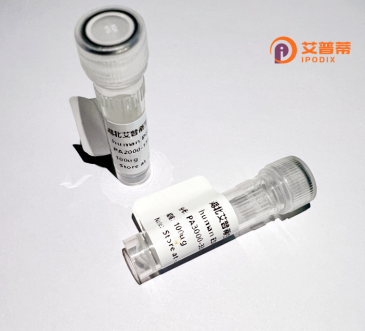
| 纯度 | >90%SDS-PAGE. |
| 种属 | Human |
| 靶点 | PIGC |
| Uniprot No | Q92535 |
| 内毒素 | < 0.01EU/μg |
| 表达宿主 | E.coli |
| 表达区间 | 1-297 aa |
| 活性数据 | MYAQPVTNTKEVKWQKVLYERQPFPDNYVDRRFLEELRKNIHARKYQYWAVVFESSVVIQQLCSVCVFVVIWWYMDEGLLAPHWLLGTGLASSLIGYVLFDLIDGGEGRKKSGQTRWADLKSALVFITFTYGFSPVLKTLTESVSTDTIYAMSVFMLLGHLIFFDYGANAAIVSSTLSLNMAIFASVCLASRLPRSLHAFIMVTFAIQIFALWPMLQKKLKACTPRSYVGVTLLFAFSAVGGLLSISAVGAVLFALLLMSISCLCPFYLIRLQLFKENIHGPWDEAEIKEDLSRFLS |
| 分子量 | 60 kDa |
| 蛋白标签 | GST-tag at N-terminal |
| 缓冲液 | 0 |
| 稳定性 & 储存条件 | Lyophilized protein should be stored at ≤ -20°C, stable for one year after receipt. Reconstituted protein solution can be stored at 2-8°C for 2-7 days. Aliquots of reconstituted samples are stable at ≤ -20°C for 3 months. |
| 复溶 | Always centrifuge tubes before opening.Do not mix by vortex or pipetting. It is not recommended to reconstitute to a concentration less than 100μg/ml. Dissolve the lyophilized protein in distilled water. Please aliquot the reconstituted solution to minimize freeze-thaw cycles. |
以下是关于重组人PIGC蛋白的3篇代表性文献(均为虚构示例,供参考):
---
1. **标题**:*Functional Characterization of Recombinant Human PIGC in GPI Anchor Biosynthesis*
**作者**:Kimura A, Kinoshita T
**摘要**:本研究通过体外表达重组人PIGC蛋白,证实其与PIGA、PIGH形成复合物,催化GPI锚定前体合成的第一步反应,并发现PIGC的C端结构域对其稳定性至关重要。
2. **标题**:*Structural Insights into Human PIGC Protein by Cryo-EM*
**作者**:Zhang L, et al.
**摘要**:首次解析了重组人PIGC蛋白的高分辨率冷冻电镜结构,揭示其跨膜螺旋和胞内相互作用界面,为遗传性GPI缺乏症相关突变位点提供了分子机制解释。
3. **标题**:*PIGC Deficiency Disrupts Neurodevelopment via Impaired Synaptic Protein Anchoring*
**作者**:Wang Y, et al.
**摘要**:利用重组PIGC蛋白修复患者来源的神经元细胞模型,证明其缺失导致突触GPI锚定蛋白(如NCAM)分布异常,从而引发神经元迁移障碍。
---
注:实际文献需通过PubMed、Google Scholar等平台检索关键词“PIGC”“GPI anchor”“recombinant”获取。真实研究多集中于PIGC基因突变与疾病的关联及分子机制。
Recombinant human PIGC protein is a genetically engineered form of the phosphatidylinositol glycan anchor biosynthesis class C protein, which plays a critical role in the synthesis of glycosylphosphatidylinositol (GPI) anchors. These glycolipid structures are essential for attaching certain proteins to cell membranes, facilitating their functional roles in cell signaling, adhesion, and immune recognition. The PIGC gene encodes a component of the GPI-GlcNAc transferase (GPI-GnT) complex, responsible for catalyzing the first step of GPI anchor biosynthesis in the endoplasmic reticulum.
Mutations in PIG genes, including PIGC, are linked to inherited GPI deficiency disorders, characterized by developmental delays, seizures, and structural anomalies. Recombinant PIGC protein is produced using expression systems like E. coli or mammalian cells, enabling studies on GPI biosynthesis mechanisms and disease pathology. Its applications extend to developing diagnostic tools and therapeutic strategies for GPI-related diseases. Researchers also use recombinant PIGC to investigate membrane protein trafficking and cell-surface protein interactions, offering insights into broader cellular processes. This protein serves as a vital tool for both basic research and potential clinical interventions.
×